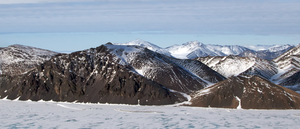Mysterious Monopole Remains Elusive
The magnetic monopole is the Yeti of the subatomic world—avidly sought but never incontrovertibly seen. Reporting in Physical Review Letters, a team of physicists argues that old, high-latitude rocks derived from the Earth’s interior should be prime hunting ground for the hypothetical particles. Although the team’s search came up empty, their strategy may offer a way to set stronger limits on the abundance of monopoles within the planet.
In standard electromagnetic theory, isolated positive and negative electric charges exist, but magnetic poles always come in pairs. Fixing that asymmetry, Paul Dirac proposed in 1931 the existence of magnetic monopoles, hypothetical stable particles of unknown mass acting as isolated north or south poles. More recently, grand unification theories seeking to combine the now-distinct strong and electroweak forces also predict the existence of monopoles, typically with masses more than 1016 times that of a proton. “Whether or not monopoles exist is one of the biggest open questions in modern physics,” says David Milstead of Stockholm University.
If they exist, monopoles would have been created as the early universe cooled, and some of them would have subsequently stuck to atomic nuclei with magnetic moments. There are too many theoretical unknowns, however, to allow good estimates of how many monopoles might be around today. Researchers have looked for monopoles in meteorites, as well as in rocks from the Earth’s crust and the Moon, but no evidence of the particles has turned up. Milstead, Philippe Mermod of the University of Geneva, and their colleagues sought to refine the search by examining high-latitude volcanic rocks where, they argue, monopoles ought to have accumulated over geological time.
Billions of years ago, any monopoles trapped in the still-molten Earth would have sunk toward the dense core, attached to atoms pulled downward by gravity. As the Earth cooled, its crust would form from material largely free of monopoles, but some monopoles would remain in the deeper mantle. Although the mantle is solid, it turns over, by convection, on a timescale of hundreds of millions of years. That slow turnover would carry monopoles down into the fluid core, where they would be drawn toward the poles by the planet’s magnetic field. Convection through the mantle would then transport many of those monopoles back up toward the surface, making monopoles about six times more plentiful in high-latitude mantle than in the planet as a whole, the team estimates.
The researchers obtained more than 24 kilograms of rock spat up from the mantle by volcanic eruptions in Iceland, Greenland, and other sites with latitudes higher than 63 degrees. “Of all of the different types of accessible rocks on Earth, these would be the best place to look for monopoles,” says Milstead.
To detect the particles, the researchers passed rock samples through the superconducting coils of a DC-SQUID magnetometer, a device that is highly sensitive to magnetic fields. When an ordinary dipole magnet travels completely through the device, its north and south poles induce opposite currents in the coils, so that no net current remains. A monopole, however, would create a lingering current that will build up as the sample is passed repeatedly through the coils. After testing all their samples, the team found no clear signature of monopoles. Considering the sensitivity of the magnetometer, the number of monopoles present could be no more than about one per ten kilograms of rock, the researchers report. That’s at least as good as, and likely better than, the results of the best previous searches, such as in meteorites.
The negative result doesn’t rule out the existence of monopoles or end the search for them. “We could still look at larger amounts of rocks,” says Arttu Rajantie of Imperial College London. “One can also search for monopoles in cosmic rays.”
Rajantie recently joined MoEDAL, a monopole project at CERN’s Large Hadron Collider (LHC) in Geneva. He hopes that some of the LHC’s proton collisions will spit out monopoles that leave telltale ionization traces in the machine’s detectors, although the collision energy is not enough to produce the heavier monopoles predicted by unification theories.
“Progress in this field is slow,” says Michael Longo of the University of Michigan, Ann Arbor, who probed meteorites for monopoles nearly two decades ago. “I doubt I’ll be around when the first monopole is sighted, but I’m hopeful that they will be seen someday.”
–Devin Powell
Devin Powell is a freelance science writer in Washington, D.C.





